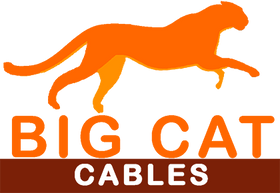Coaxial Cable
What is coaxial cable? Generally speaking, it’s cable that includes conductors that share an axis. The axis of a cable is the imaginary line that runs down the center of the length of cable, seen in Figure 1.

Figure 1. Axis of a cylinder
How do two conductors in the same cable share an axis? One of the conductors, called the center conductor, goes right down the axis of the cable. The other conductor, called the outer conductor or the shield, wraps around an insulating material called a dielectric, which spaces the shield an equal distance away from the center conductor. You can get an idea of this arrangement from Figure 2. In cross-section, you can think of the center conductor as a line, and the outer conductor as a circle, and they both share the same axis!

Figure 2. Structure of a coaxial cable
Coaxial cable is used for data, video, and voice transmission. It’s primarily found in radio-frequency antenna installations, cable television, satellite antenna installations, and yes, even Ethernet.
Ethernet Cable (Balanced Twisted Pair Cable)
Balanced twisted pair cable is commonly referred to as “Ethernet cable” or “network cable.” How is it different from coaxial cable? In just about every way except they both usually contain copper. There is nothing in a twisted pair cable that shares an axis with anything else. In fact, it is the cable’s complete lack of symmetry that gives it its most valuable property. It is made of four pairs of insulated conductors. The conductors of each pair are twisted around each other (Figures 3, 4).

Figure 3. The four pairs of conductors in a balanced twisted pair cable

Figure 4. Cross section of balanced twisted pair cable
Not only is each pair twisted, but each pair is twisted at a different rate (coils per inch). That way, conductors within the cable are rarely, if ever, oriented parallel to any other conductors inside the cable, or outside. This allows the conductors to avoid noise and signal loss due to electromagnetic interference (EMI).
Like most things that are important within a culture, twisted pair cable goes by many names. In addition to twisted pair cable it is called datacom cable, network cable, data center cable, enterprise cable and category cable, but most people just call it Ethernet cable.
Optical Fiber
So what about fiber optic cable? Look at the construction of an optical fiber cable in Figure 5. All of those components obviously share the same axis. So isn’t that coaxial cable, too?

Figure 5. Structure of an optical fiber cable
Nope. There’s only one conductor in there. Two conductors need to share the same axis for it to be a coaxial cable. But you know what? It is an Ethernet cable! That’s right; coaxial cable, balanced twisted pair cable and optical fiber cable are all Ethernet cables.
Final Thoughts
So, if these different types of media are all used to transmit signals over Ethernet networks, why is it that only balanced twisted pair cable is called Ethernet cable? Because the vast majority of people have only ever used twisted pair cables to connect to a network.
The 10BASE-T Ethernet standard made the switch to twisted-pair cable in 1990. That happens to be the same year that the first web browser was written at CERN, a research institution in Switzerland. The World Wide Web became available to mainstream users in 1994 with the release of the Mosaic browser, later called Netscape. Over the next two decades use of the Internet exploded to include users from all over the world with virtually unlimited content. Almost all of these users connected to their networks with twisted pair cable.
Big Cat Cables presents the information on our website, including the blog and live chat support, as a service to our customers and other visitors to our website subject to our website terms and conditions. While the information on this website is about data networking and electrical issues, it is not professional advice and any reliance on such material is at your own risk.

